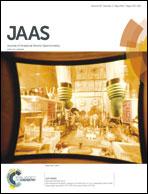Effect of oxygen in sample carrier gas on laser-induced elemental fractionation in U–Th–Pb zircon dating by laser ablation ICP-MS
Abstract
Thermal breakdown of zircon during laser ablation sampling for ICP-MS analysis results in decoupling of Si from Zr, and Pb from U + Th, following the reaction ZrSiO4(U, Th, Pb) = ZrO2(U, Th) + SiO2(Pb). The rate of the laser-induced elemental fractionation can be linked to the concentration of oxygen in the ambient He sample carrier gas. Deposition of ZrO2 and SiO2 on the walls of the ablation craters is enhanced by the presence of oxygen during ablation, and the composition of the deposit is dominated by ZrO2. This study shows that even a small amount of oxygen (e.g., 500 ppm) added to the sample carrier gas can shift the U–Pb ages of zircon by as much as 9%, which is well beyond the typical analytical uncertainty of LA-ICP-MS zircon dating. Addition of up to 2000 ppm oxygen to the sample carrier also increases the instrument sensitivity by as much as 3 times for light elements and ca. 1.5 times for heavy elements. The increase in sensitivity is accompanied by an increase in the U and Th oxide formation, suggesting that the signal enhancement is not related to the concomitant M+ and MO+ ion formation, but rather to the improved atomization and ionization capabilities of the mixed gas ICP. The study shows that maintaining a constant level of O2 throughout the ablation cell over an analytical session at the time of analysis is a prerequisite for further improvements in the repeatability of U–Pb LA ICP-MS dating of zircon.


 Please wait while we load your content...
Please wait while we load your content...